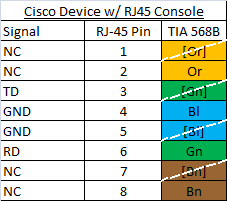These best practices espouse having a dedicated physical console connection to network equipment for management. Assuming your device is within RS232 range of your management workstation, this would likely mean connecting to your devices' RS232 console ports over structured UTP already in place.
I have a collection of three current Cisco devices all within RS232 range of my management workstation. Their RS232 console ports are not all the same, however:
Device Console Connector
====== =================
ASA5505 RJ45 Jack
SG500X DE9 Male
SG300 DE9 Male
Of course, it is trivial to connect to the RJ45 console port using structured ethernet cabling. When you do that, you end up with the following RS232 signal map to your UTP:

As for the DE9 console ports, the only standard to connect RS232 over RJ45-terminated UTP seems to be TIA-561 (aka RS-232D). When you do that, you end up with the following RS232 signal map to your UTP:

As you can see this results in RS232 signals on the UTP that are different for the different console port types -- and this is with a collection of just three current devices from a single vendor.
While I'm sure I could document this and make sure all admins have just the right cables/adapters available to make a successful connection it seems unnecessarily error-prone. Particularly since the console connection is often used only as a backup during stressful periods when other methods of connecting to the device have already failed.
Ideally, all RS232 on the structured cabling would follow the same pinout. I can force everything to follow TIA-561 with custom adapters at each device and workstation, but I've never seen that done anywhere else. Is there a good way to standardize RS232 over RJ45 pinouts?
